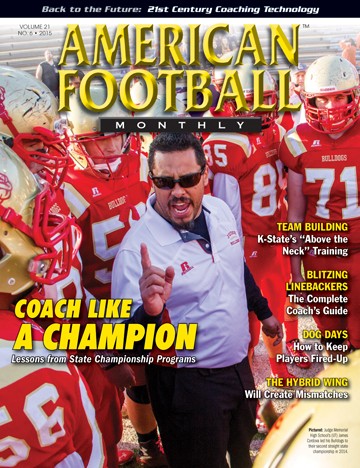Article CategoriesAFM Magazine
|
Leadership Strategies: Developing a Leadership Councilby: AFM Editorial Staff© More from this issue Jerome Learman was a high school coach for 20 years and 13 as a head coach. He received his doctorate in 2005 from Michigan State in Kinesiology. Learman is currently teaching at both Michigan State and Central Michigan University. While coaching, Learman developed a leadership council for juniors and seniors who received leadership training to become captains. American Football Monthly spoke to Coach Learman about his leadership council. After taking over for Craig Bohl, North Dakota State’s Chris Klieman – in his first year Why did you start the leadership council? A few of the players were captains or in line to be captain and I had to remove them. The mission was simple - to teach kids what it means to lead the right way as opposed to what they have seen on television. From this, it gave us a pool of people that would become captains. It has 10 chapters, all dealing with leadership. What is a leader? What types of leaders are there? Each chapter has questions and assignments. One deals with who do you look up to as a leader? Then, after a series of additional questions, everyone is rated on their commitment level. It also has examples of leaders being the hardest workers, first at practice and last to leave. It would take about 30 minutes to read a chapter and an hour to answer the questions and assignments. One example would be an interview of a captain from another sport that you look up to. We would then meet for an hour discussing the questions and how they applied to life as well as football. I have found the premise to be true that sometimes a person has to follow before he can lead. I would often assign a player a different part of the book and have them read that and then report to the team what the topic was, what they had learned from it and how it applied to them. Once the training was complete we would still meet once a week to discuss any issues that were major discipline violations. The leadership council would meet to hear the case and then determine if any punishment was warranted. One of the chapters discusses a ‘Commitment Contract.’ It is understood that the entire team will sign the ‘Commitment Contract.’ It also establishes rules and goals for the team with the understanding that everyone must be committed to each and every goal. Another section of the manual is entitled, “The Teammate Mental Game Assessment.” It’s a series of situations in which, as a leader, you are counted on to help your teammates. You learn about your teammates – each one being different – through simulated situations. You are taught how to deal with controversial issues as well as how to motivate your teammates. I found the manual very effective. This is our team: Dr. William Eickhoff, founding member of the John Maxwell Team, certified coach, trainer and speaker in the field of leadership development. • Paul Herfurth, Executive Advisor, The Pacific Institute. • Chet Tart, Radio Executive, Talent Coach. • AFM Editorial Staff. • Football community leaders and coaches throughout the nation. |
|
| HOME |
MAGAZINE |
SUBSCRIBE | ONLINE COLUMNISTS | COACHING VIDEOS |
Copyright 2024, AmericanFootballMonthly.com
All Rights Reserved




